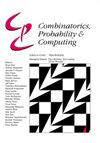Molecular Interactions within the Crystal Packing of Busulfan (DNA Cross-Linking Agent) by Hirshfeld Surface Analysis
IF 0.8
4区 数学
Q3 COMPUTER SCIENCE, THEORY & METHODS
引用次数: 0
Abstract
Non-Covalent Interactions (NCIs) play a vital role in the chemical process. Certain Experimental and theoretical approaches provide information about the stronger and weaker interactions. In the present work, we have implemented Hirshfeld charges based surface mapping to find the weaker interactions between the molecules of busulfan. The main objective of this work is to recognize the non-covalent interactions which are not simply drawn from the experimental and conventional theoretical approach. It aims to provide more insightful information into the crystallographic structure. In the present work, we have implemented a Hirshfeld surface mapping which incorporates periodic boundary conditions of the crystalline geometry. Each point of the isosurface is defined by two distances i.e. de, the distance from the point to the nearest atom outside to the surface and di, the distance to the nearest atom inside the surface. Also, for precise identification of intermolecular interactions, mapping by normalized contact distance dnorm is also considered. Fingerprint plot di vs de for various types of interactions were also provided. The Hirshfeld surface and fingerprint plot show the very weak H···H interactions in addition to the O···H interactions. This enables the visualization of very weak interactions. This proposed work on Hirschfeld surface analysis accounts for the solidstate environment of the busulfan, crystallographic parameters and packing information. Hence, the interactions obtained for monomer and extended molecular framework in this work are more reliable to study the intermolecular interactions. The 2D finger print plots revealed the predominant O⋅⋅⋅H interactions within the crystal packing. In addition to O⋅⋅⋅H interactions, H⋅⋅⋅H interaction were also identified.用Hirshfeld表面分析法研究Busulfan (DNA交联剂)晶体填料中的分子相互作用
非共价相互作用(nci)在化学过程中起着重要作用。某些实验和理论方法提供了关于强相互作用和弱相互作用的信息。在目前的工作中,我们已经实现了基于Hirshfeldcharges的表面映射,以发现busulfan分子之间较弱的相互作用。这项工作的主要目的是认识非共价相互作用,这不是简单地从实验和传统的理论方法得出的。它旨在为晶体结构提供更有洞察力的信息。在目前的工作中,我们已经实现了一个Hirshfeld表面映射,其中包含了晶体几何的周期性边界条件。等边面的每个点由两个距离定义,即de,点到表面外最近的原子的距离,di,点到表面内最近的原子的距离。此外,为了精确识别分子间相互作用,还考虑了标准化接触距离范数的映射。并给出了不同类型交互作用的指纹图谱。Hirshfeld表面和指纹图谱显示除了O··H相互作用外,H··H相互作用非常弱。这使得非常弱的交互变得可视化。这项提出的赫希菲尔德表面分析工作考虑了硫丹的固态环境、晶体学参数和堆积信息。因此,本文得到的单体相互作用和扩展分子框架的相互作用对于研究分子间相互作用更为可靠。二维指纹图谱揭示了晶体填料中主要的O⋅⋅H相互作用。除了O⋅⋅H相互作用外,还确定了H⋅⋅H相互作用。
本文章由计算机程序翻译,如有差异,请以英文原文为准。
求助全文
约1分钟内获得全文
求助全文
来源期刊

Combinatorics, Probability & Computing
数学-计算机:理论方法
CiteScore
2.40
自引率
11.10%
发文量
33
审稿时长
6-12 weeks
期刊介绍:
Published bimonthly, Combinatorics, Probability & Computing is devoted to the three areas of combinatorics, probability theory and theoretical computer science. Topics covered include classical and algebraic graph theory, extremal set theory, matroid theory, probabilistic methods and random combinatorial structures; combinatorial probability and limit theorems for random combinatorial structures; the theory of algorithms (including complexity theory), randomised algorithms, probabilistic analysis of algorithms, computational learning theory and optimisation.
 求助内容:
求助内容: 应助结果提醒方式:
应助结果提醒方式:


